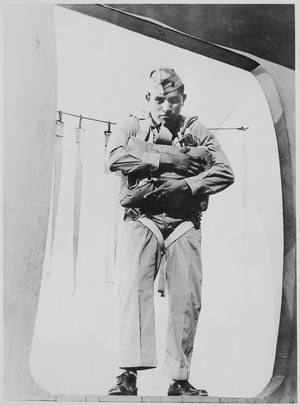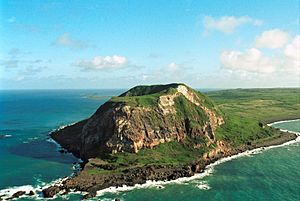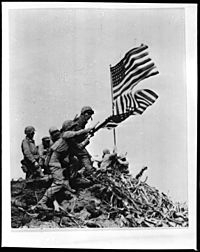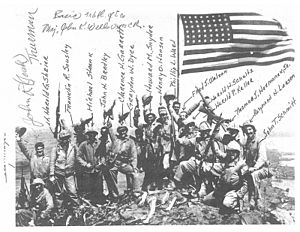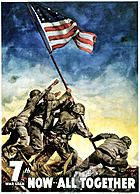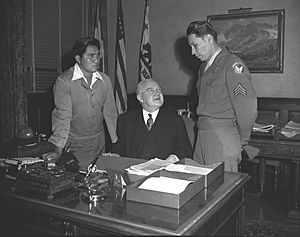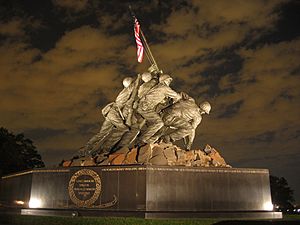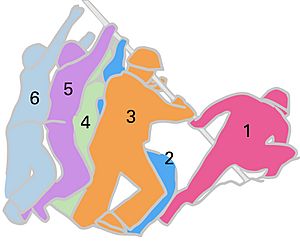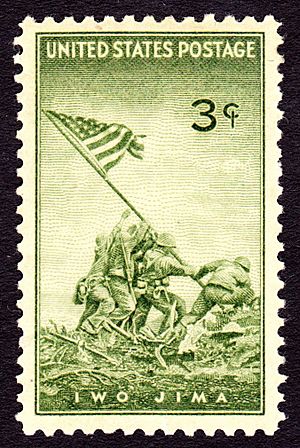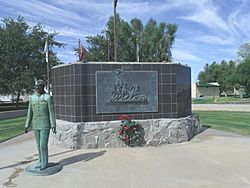Ira Hayes facts for kids
Quick facts for kids
Ira Hayes
|
|
|---|---|
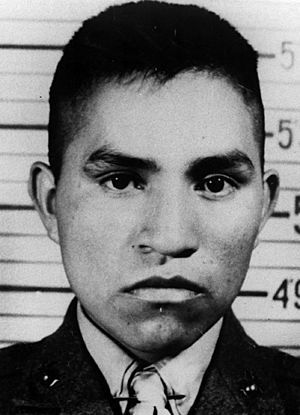
Marine Corps recruit photo of Hayes in 1942
|
|
| Birth name | Ira Halsey Hayes |
| Nickname(s) | "Chief Falling Cloud", "Chief" |
| Born | January 12, 1923 Sacaton, Arizona, U.S. |
| Died | January 24, 1955 (aged 32) Bapchule, Arizona, U.S. |
| Buried |
Section 34, Arlington National Cemetery
|
| Allegiance | United States |
| Service/ |
United States Marine Corps |
| Years of service | 1941–1945 |
| Rank | Corporal |
| Unit |
|
| Battles/wars | World War II |
| Awards |
|
Ira Hamilton Hayes (born January 12, 1923 – died January 24, 1955) was a brave Akimel O'odham Native American and a United States Marine during World War II. He was a member of the Gila River Indian Community in Arizona.
Hayes joined the United States Marine Corps Reserve in 1942. He volunteered to become a special paratrooper, known as a Paramarine. He fought in important battles like the Bougainville and Iwo Jima in the Pacific War.
Ira Hayes is famous for being one of the six flag raisers in the well-known photograph Raising the Flag on Iwo Jima. This picture was taken by Joe Rosenthal on February 23, 1945. A smaller flag was first raised on Mount Suribachi on Iwo Jima. It was later replaced by a larger flag, and Hayes was part of that second flag-raising team. This photo became a symbol of the war. After the battle, Hayes and two other Marines helped raise money for the war effort. In 1946, he helped correct the identity of one of the Marines in the famous photo.
After the war, Hayes struggled with post-traumatic stress disorder (PTSD). On November 10, 1954, he attended the dedication of the Marine Corps War Memorial in Arlington, Virginia. This memorial was built to look like the famous flag-raising photo. Ira Hayes passed away on January 24, 1955. He was buried with full military honors at Arlington National Cemetery.
Hayes' story has been shared in many ways, including art and films. In 1949, he played himself in the movie Sands of Iwo Jima with John Wayne. His life also inspired the film The Outsider (1961), starring Tony Curtis. The movie led to the song "The Ballad of Ira Hayes" by Peter La Farge, which became popular after Johnny Cash recorded it. In 2006, Adam Beach played Hayes in the movie Flags of Our Fathers, directed by Clint Eastwood.
Contents
Early Life and Joining the Marines
Ira Hayes was born on January 12, 1923, in Sacaton, Arizona. This town is part of the Gila River Indian Community. He was the oldest of six children. His parents were Nancy and Joseph Hayes. Joseph Hayes was a veteran of World War I. He supported his family by farming and harvesting cotton. Nancy Hayes was a dedicated Presbyterian and a Sunday school teacher.
Ira was known by his family and friends as a shy and quiet child. His niece, Sara Bernal, said he was very quiet and didn't speak unless spoken to first. His friend Dana Norris also noted that Ira was a quiet person. Even so, Ira was a smart child. He learned to read and write by age four and loved to read. He had a good understanding of the English language, which was not common for many Pima people at the time.
In 1932, his family moved to Bapchule, Arizona. Ira and his siblings went to grade school in Sacaton and high school at the Phoenix Indian School in Phoenix, Arizona.
When the Japanese attack on Pearl Harbor happened in December 1941, Ira Hayes was working as a carpenter. He told a classmate that he was determined to join the United States Marine Corps. Before joining the military, he also worked for the Civilian Conservation Corps in 1942.
Serving in the Marine Corps
Becoming a Paramarine
Ira Hayes joined the Marine Corps Reserve on August 26, 1942. He completed his basic training in San Diego. In October, he volunteered for special paratrooper training. This training took place at the Marine Parachute School near San Diego.
Ira Hayes made history by becoming the first Pima person to earn his paratrooper wings. He was given the nickname Chief Falling Cloud. On November 30, he graduated and received his silver "jump wings." The next day, he was promoted to private first class.
In December 1942, Hayes joined Company B, 3rd Parachute Battalion. This unit was part of the 3rd Marine Division. In March 1943, Hayes sailed to New Caledonia with his battalion. They later moved to Guadalcanal. In October, they went to Vella Lavella for duty.
On December 4, Hayes landed on Bougainville with his battalion. He fought against the Japanese as an automatic rifleman during the Bougainville Campaign. His unit then returned to Guadalcanal. In February 1944, the Paramarines were sent back to California. The 1st Parachute Regiment was officially ended at Camp Pendleton, California.
Hayes was then moved to Company E, 2nd Battalion, 28th Marine Regiment. This unit was part of the new 5th Marine Division. In September, Hayes sailed to Hawaii with his company. They trained there for the invasion of Iwo Jima.
The Battle of Iwo Jima
The 5th Marine Division landed on Iwo Jima on February 19, 1945. Hayes' unit, Easy Company, landed on the southern beach near Mount Suribachi. The island was defended by over 20,000 Japanese soldiers. These soldiers were hidden in strong defenses and were ready to fight until the end. Only about 200 Japanese soldiers survived the battle.
First Flag Raising
On February 23, Lieutenant Colonel Chandler W. Johnson ordered a group of Marines to climb Mount Suribachi. Their mission was to capture the top and raise a flag to show it was secure. Captain Dave Severance put together a 40-man patrol for this mission. First Lieutenant Harold Schrier led the patrol.
After four days of fighting, the Marines reached the mountain slopes. At 8:30 AM, the patrol began climbing the east side of Suribachi. Less than an hour later, they reached the top. After a short fight, Lt. Schrier and his men captured the summit. They found a Japanese steel pipe and attached the flag to it. Around 10:30 AM, Lt. Schrier, Platoon Sergeant Ernest Thomas, Sergeant Henry Hansen, and Corporal Charles Lindberg raised the first flag.
Marines, sailors, and Coast Guardsmen on the beach below cheered loudly. Sergeant Hansen, Private Phil Ward, and Navy corpsman John Bradley helped hold the flagstaff steady because of strong winds. A photographer named Louis R. Lowery took several pictures of the men raising this first flag. Platoon Sgt. Thomas and Sgt. Hansen were later killed on Iwo Jima.
Second Flag Raising
The first flag on Mount Suribachi was thought to be too small. It couldn't be seen by all the Marines fighting on other parts of Iwo Jima. So, Marine commanders decided to raise a larger flag.
In the early afternoon, Captain Severance ordered Sergeant Michael Strank to go up Mount Suribachi. Sgt. Strank was a rifle squad leader. He took Corporal Harlon Block, Private First Class Hayes, and Private First Class Franklin Sousley with him. Private First Class Rene Gagnon, a messenger, was ordered to bring the new, larger flag up the mountain. He was also to bring the first flag back down.
When all five Marines were at the top, Pfc. Hayes and Pfc. Sousley found a Japanese steel pipe. They carried it to Sgt. Strank and Cpl. Block. The larger flag was attached to this pipe. As Sgt. Strank and his three Marines were about to raise it, he asked two other Marines from the first patrol to help.
Around 1:00 PM, Lt. Schrier ordered the second flag to be raised and the first flag to be taken down. The second flag was raised by Sgt. Strank, Cpl. Block, Pfc. Hayes, Pfc. Sousley, Pfc. Harold Schultz, and Pfc. Harold Keller. After it was raised, rocks were added to the base of the flagstaff. Three ropes were also used to keep it steady in the strong winds.
The raising of this second American flag on Mount Suribachi on February 23, 1945, was captured by Associated Press photographer Joe Rosenthal. His photo became a famous symbol of World War II.
On March 14, another American flag was raised on a flagpole by two Marines. This was done during a ceremony to show that the Marines had taken control of Iwo Jima. The flag that Hayes helped raise on Mount Suribachi was then taken down.
Hayes continued to fight on the island until it was secured on March 26. He attended a service for American troops buried there. Hayes left Iwo Jima with his unit for Hawaii on March 27. His company, Easy Company, had many casualties. Hayes was one of only five Marines left from his original group of forty-five men. Sgt. Strank and Cpl. Block were killed on Iwo Jima on March 1. Pfc. Sousley was killed on March 21.
War Bond Tour
After the battle, President Roosevelt ordered that the flag raisers in Joe Rosenthal's photograph be sent to Washington, D.C. They were to help boost public morale. Pfc. Rene Gagnon was the first to report to Marine Corps headquarters. He named the six flag raisers, including Ira Hayes. Hayes and Navy corpsman John Bradley were also ordered to Washington.
President Roosevelt passed away on April 12, and Harry S. Truman became President. Hayes and Bradley arrived in Washington around April 19. They were questioned about the flag raisers. Hayes said that the man identified as Sgt. Hansen in the photo was actually Cpl. Harlon Block. However, the Marine interviewer told Hayes that the names had already been released publicly.
Pfc. Gagnon, Pfc. Hayes, and Navy corpsman Bradley were asked to help with the Seventh War Loan drive. This was a campaign to sell war bonds and help pay for the war. On April 20, they met President Truman at the White House. They showed him their positions in the flag-raising poster. A press conference was also held where they answered questions about the flag raising.
On May 9, Hayes, Gagnon, and Bradley raised the same flag from Mount Suribachi during a ceremony in Washington. This kicked off the bond-selling tour. The tour began on May 11 in New York City. On May 24, Pfc. Hayes was ordered back to his unit in Hawaii. He left Washington on May 25 and rejoined his company on May 29. Gagnon and Bradley finished the tour on July 4. The bond tour visited 33 American cities and raised over $26 billion for the war effort.
On June 19, Pfc. Hayes was promoted to corporal. He served in Japan as part of the occupation duty from September to October 1945. He was honorably discharged from the Marine Corps on December 1, 1945. In February 1946, Hayes received a Navy Commendation for his excellent service in combat during World War II.
Life After World War II
After the war, Ira Hayes tried to live a normal life. He received many letters and people would visit him on the reservation. They would ask, "Are you the Indian who raised the flag on Iwo Jima?" Hayes rarely spoke about the flag raising, but he was proud of his service in the Marine Corps.
Hayes was bothered that Harlon Block was still being incorrectly identified as "Hank" Hansen in the famous photo. In May 1946, Hayes traveled 1,300 miles from Arizona to Texas. He went to Harlon Block's parents' farm to tell them the truth about their son being in the photograph. Hayes was key in getting the Marine Corps to officially correct the identity of the flag raisers in January 1947. Block's family was very thankful to Hayes.
In 1949, Hayes appeared briefly as himself in the movie Sands of Iwo Jima. In the film, John Wayne hands the American flag to Gagnon, Hayes, and Bradley. At that time, they were thought to be the three surviving flag-raisers.
After this, Hayes found it hard to keep a steady job. He worked various jobs, including being a driver for Elizabeth Martin, the former wife of Dean Martin. Hayes attended the Marine Corps War Memorial dedication on November 10, 1954. He met President Dwight D. Eisenhower, who praised him as a hero. When a reporter asked Hayes how he liked the attention, Hayes simply said, "I don't."
His discomfort with fame and his post-war difficulties were described in a book called "The Outsider" by William Bradford Huie. This book led to the 1961 film The Outsider, starring Tony Curtis as Hayes. The 2006 film Flags of Our Fathers also showed that Hayes suffered from post-traumatic stress disorder (PTSD).
Death and Burial

Ira Hayes was found dead on the morning of January 24, 1955, near his home in Sacaton, Arizona.
On February 2, 1955, Hayes was buried in Arlington National Cemetery. At his funeral, Rene Gagnon said about Hayes: "Let's say he had a little dream in his heart that someday the Indian would be like the white man — be able to walk all over the United States."
Marine Corps War Memorial
The Marine Corps War Memorial (also known as the Iwo Jima Memorial) in Arlington, Virginia, was dedicated on November 10, 1954. The sculptor, Felix de Weldon, created the monument based on the famous photograph of the second flag raising on Mount Suribachi. Ira Hayes is shown as the sixth bronze figure at the base of the flagstaff on the memorial. The bronze figures are 32 feet (9.8 meters) tall.
President Dwight D. Eisenhower attended the dedication ceremony. Also present were Vice President Richard Nixon, Secretary of Defense Charles E. Wilson, and General Lemuel C. Shepherd, the Commandant of the Marine Corps. Ira Hayes, one of the three surviving flag raisers shown on the monument, was also seated at the front. Other attendees included John Bradley (who was later found not to be a flag raiser), Rene Gagnon (also later found not to be a flag raiser), and the mothers of Michael Strank, Harlon Block, and Franklin Sousley.
The memorial has these words carved into it:
- In Honor And Memory Of The Men of The United States Marine Corps Who Have Given Their Lives To Their Country Since 10 November 1775
1993 Marine Corps Commemoration
On November 10, 1993, the United States Marine Corps held a ceremony at the Marine Corps War Memorial. This event celebrated the 218th anniversary of the Marine Corps. General Carl Mundy, the USMC Commandant, spoke about Ira Hayes:
One of the pairs of hands that you see outstretched to raise our National flag on the battle-scarred crest of Mount Suribachi so many years ago, are those of a Native American ... Ira Hayes ... a Marine not of the ethnic majority of our population.
Were Ira Hayes here today ... I would tell him that although my words on another occasion have given the impression that I believe some Marines ... because of their color ... are not as capable as other Marines ... that those were not the thoughts of my mind ... and that they are not the thoughts of my heart.
I would tell Ira Hayes that our Corps is what we are because we are of the people of America ... the people of the broad, strong, ethnic fabric that is our nation. And last, I would tell him that in the future, that fabric will broaden and strengthen in every category to make our Corps even stronger ... even of greater utility to our nation. That's a commitment of this commandant ... And that's a personal commitment of this Marine.
Military Awards and Honors
Ira Hayes received several military awards for his service. His Navy Commendation Ribbon was upgraded to the Navy and Marine Corps Commendation Medal with a Combat "V". This was for his excellent service in combat. He also earned the Combat Action Ribbon for fighting in World War II.
Hayes' military decorations and awards include:
 |
||
 |
||
| Badge | Parachutist Badge | |||||||||||
|---|---|---|---|---|---|---|---|---|---|---|---|---|
| 1st row | Navy and Marine Corps Commendation Medal with Combat "V" |
|||||||||||
| 2nd row | Navy Combat Action Ribbon | Navy Presidential Unit Citation with 1 5⁄16" silver star |
American Campaign Medal | |||||||||
| 3rd row | Asiatic-Pacific Campaign Medal with 4 bronze campaign stars |
World War II Victory Medal | Navy Occupation Service Medal | |||||||||
| Badge | Rifle Sharpshooter Badge | |||||||||||
U.S. Marine Corps Commendation
Ira Hayes received a special commendation from the Marine Corps. This was for his brave and effective service during World War II. The commendation highlighted his duties in battles on Vella Lavella, Bougainville, and Iwo Jima. It noted that he performed his duties well, even under heavy enemy fire. His courage and dedication were an example to others.
Ira Hayes in Popular Culture
Hayes' story has been told in many ways, including songs, movies, and books.
The song "The Ballad of Ira Hayes" was written by Peter La Farge. Many artists have covered it, including Johnny Cash, Kris Kristofferson, Pete Seeger, Townes Van Zandt, and Bob Dylan. In 1964, Johnny Cash's version reached number 3 on the country music charts.
Ira Hayes also appeared as himself in the 1949 John Wayne film, Sands of Iwo Jima. In the 1960 TV movie The American, he was played by World War II Marine veteran Lee Marvin. Tony Curtis played Hayes in the 1961 film The Outsider. In the 2006 movie Flags of Our Fathers, directed by Clint Eastwood, Hayes was played by Adam Beach. This movie was based on the book of the same name by James Bradley and Ron Powers.
Hayes is also mentioned in poems and books. The poet Ai dedicated her poem "I Can't Get Started" to Hayes. He is also mentioned in "Petroglyphs of Serena" by Adrian C. Louis. He appears in the book "Code Talker" by Joseph Bruchac and in "Indian Killer" by Sherman Alexie.
Monuments and Memorials
Several places and honors are named after Ira Hayes:
- The Marine Corps War Memorial in Arlington, Virginia, features him as a flag-raising figure.
- Hayes Peak, a mountain in the Sierra Estrella in Phoenix, Arizona, is named after him.
- Ira H. Hayes High School is located in Bapchule, Arizona.
- Ira Hayes Park, with a statue, is in Sacaton, Arizona.
- The Marine Corps League, Ira Hayes Detachment 2, is in Phoenix, Arizona.
- The American Legion, Ira Hayes Post 84, is in Sacaton, Arizona.
See also
 In Spanish: Ira Hayes para niños
In Spanish: Ira Hayes para niños


